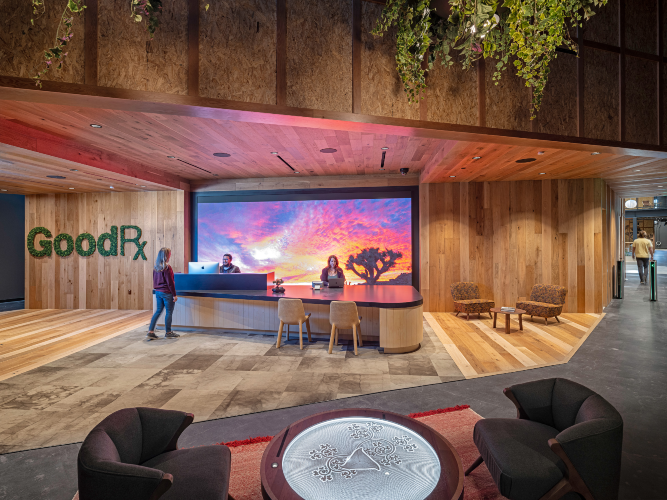
In the year since, GoodRx and its consumer-focused health care apps have managed to hold their own and even thrive despite an escalating threat from a prescription drug discount program launched by ecommerce giant Amazon.com Inc. late last year.
GoodRx has ridden a rebound in consumer prescriptions, reaped gains from public outreach deals with pharmaceutical manufacturers and begun to see a payoff from its diversification strategy.
The company’s most recent quarterly earnings saw gains in revenue and the numbers of monthly customers and subscribers. Revenue of $177 million was up 43% over second quarter 2020 while the number of monthly customers rose 36% to top 6 million, and the number of subscribers surged 86% to 1.05 million.
These increases follow slightly smaller percentage gains in all three metrics for the first quarter and for the full year 2020 compared to 2019.
GoodRx’s robust revenue performance “has been driven by a strong recovery in prescription volumes,” SVB Leerink analyst Stephanie Davis said in her most recent report after the company’s earnings release last month. “Management expects this trend to continue to improve throughout the year.”
The growth in revenue has been slow to translate into increased profits, primarily because of huge IPO-related payouts to co-founders and Co-Chief Executives Trevor Bezdek and Doug Hirsch. While the $500 million-plus in payouts will take place through stock awards over time, the company recorded the bulk of the payouts during the fourth quarter, resulting in a loss of nearly $300 million. There was also some spillover into the first quarter of this year, when the company recorded a mere $1.7 million in earnings.
It was only in the second quarter that the payouts’ drag on earnings lessened enough to show more typical net income of $31 million.
As for stock performance, shares closed Sept. 13 at $44.22, down about 12% from the $50.50 a share close on the first day of trading on Sept. 21, 2020. But large portions of that drop came after a pair of announcements from Amazon on its prescription drug discount program.
In November, the Seattle-based ecommerce behemoth introduced a prescription medication discount program called PrimeRx. That sent GoodRx’s share price plunging by 28% as investors feared Amazon’s deep pockets and huge reach would crowd out GoodRx’s prescription drug app. Then in May, Amazon announced expanded comparison pricing options with its discount card, which in turn pushed GoodRx’s share price down another 4%.
After each Amazon announcement, Bezdek and Hirsch said Amazon’s program was not in direct competition with GoodRx. Hirsch repeated that last week.
“Amazon is one pharmacy while GoodRx is the entire marketplace,” Hirsch said.
According to a letter he and GoodRx co-founder Bezdek wrote to preface last year’s public offering registration, Hirsch decided to shop around. He found the same prescription drug for as low as $250 at another pharmacy and in the process learned just how varied prescription drug prices could be.
That’s when he decided to team up with his friend and fellow tech veteran Bezdek to create a platform to help consumers find the lowest prescription drug price in their area. And so, GoodRx was born in 2011.
The company now has the ability to price drugs at 70,000 pharmacies across the United States. It makes money from fees it charges, either on individual prescription purchase transactions or from pharmacy benefit managers.
GoodRx also makes money on subscriptions that offer customers prescription discount cards and through an agreement to operate a pharmacy discount card service for Cincinnati-based supermarket retailer Kroger Co.
But its fastest growing segment is a set of arrangements with 19 of the top 20 pharmaceutical companies to enable them to boost patient and consumer awareness of drug
That segment grew nearly three-fold in revenue in the second quarter compared with the same period last year.
That was the first move in GoodRx’s new strategy to become a diversified consumer-oriented health technology platform. Armed with cash from its public offering, GoodRx earlier this year acquired two digital health businesses.
The first was New York-based HealthiNation Inc., the operator of an online health care video library, with the aim of giving consumers access to information on nutrition, healthy lifestyles and chronic medical conditions or diseases.
The other deal was to buy competitor platform, RxSaver, from San Antonio, Texas-based Vericast Corp., a payment and marketing company controlled by billionaire deal-maker Ronald Perelman.
Last month, GoodRx entered into an agreement with Arlington, Va.-based Surescripts, a health information network, to deliver drug pricing information to physicians and other prescribers through electronic medical records systems.
Also last month, GoodRx moved into the insurance arena through a partnership with Chicago-based GoHealth Inc., a health insurance marketplace and Medicare-focused digital health company. The partnership initially allows GoodRx to guide its senior citizen customers to the most suitable and affordable Medicare Advantage plans.
“People’s lack of insurance is one of the major pain points in health care,” Hirsch said. “And a lot of people don’t know how to get insurance or don’t use their existing insurance as effectively as they could. This partnership aims to help with that.”
This diversification push has impressed analyst Davis and another analyst, Charles Rhyee of New York-based Cowen Inc.
“We like GoodRx’s strategy of expanding into complementary markets with high growth potential, such as its pharma manufacturing solutions and telehealth offerings,” Rhyee said.
He did note that, as with any company that relies on subscriptions and website visits, GoodRx does face the risk that the pace of new subscriptions could slow or that its telehealth rollout might not generate as much interest as hoped.
Meanwhile, GoodRx co-Chief Executive Hirsch said more deals will be coming in the next few quarters.
“We’ve got a slew of new product offerings for consumers in the next six months, all aimed at solving several other pain points that consumers face in obtaining health care,” he said.
